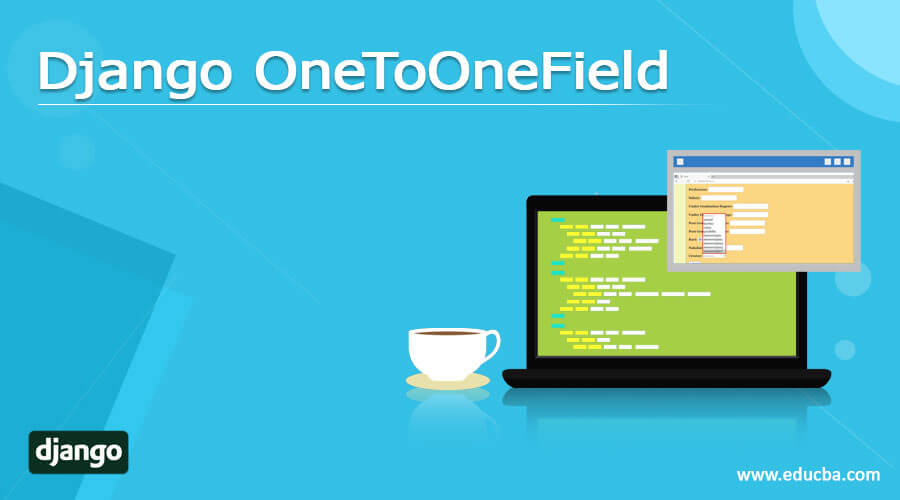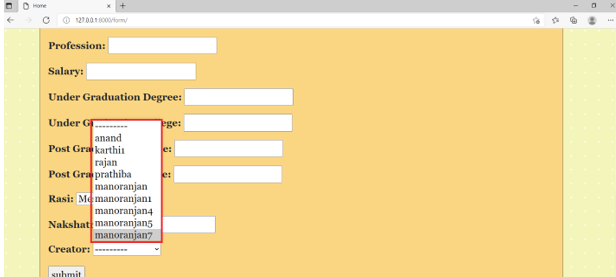
Introduction to Django OneToOneField
The Onetoonefield relationship will happen when there is a real necessity to connect two tables in a tightly coupled manner. So, for every record in the first table, there will be a corresponding record in the second table. Scenarios like these will invite a one-to-one relationship. Especially a common scenario of depicting one to one relationship is when the current table columns are too high and a large amount of columns could impact the retrieving speed of the records from the table then the table can be preferably split and made into two different tables and connectivity will be maintained between both the tables. This kind of split is called onetoone split from a table level. So here both tables will be closely coupled to one specific column. Basically, onetoonefield relationships are not very preferable.
Syntax:
OnetoOneField_name = models.OneToOneField(Table_name, null_argument, Ondelete_arguemnt)
Table call may be declared because of the first argument. So, the primary argument withinside the onetoonefield subject syntax may be similar to desk call. This desk call referred to withinside the first argument of the onetoonefield instance may be representing the desk from which the values may be inherited for the declared subject. So this could be the fee subject from which the OnetoOneField key fee is pulled over from may be related here. so being the primary argument of the technique statement and furthermore one a number of the prioritized argument used it performs a prime role. Next, the null argument is used to mention the fee null to be associated with the statistics coming in addition or already present withinside the desk. Mentioning this record as null allows the records already withinside the lower back of or new records delivered to be complete of Null rate at the same time as no rate is cited for it.
The ondelete argument has to be declared next, this is a very critical argument because this argument decides the impact between the parent table and the staging table at the instance of deletion. This means the removal of a parent table record will have a sustainable impact or no impact based on the value mentioned here. When a parent table records are removed those records will be deleted or held back from deletion based on the value associated here to this field. So the ondelete argument is also another very critical value or argument in the table.
Create a DJANGO OnetoOneField:
1) Changes in Models.py file:
First, the declaration for the onetoone Field has to be declared in the models.py file. Here the onetoonefild creator is declared to be the field that holds the onetoone relationship. This onetoone relationship exists because its field is pulled in from a different table, additionally, properties like associating the null value as True and the ondelete function is made with CASCADE.
Ex: (models.py)
from django.db import models
from django.contrib.auth.models import User
# Model variables
# Create your models here.
class Bride(models.Model):
OnetoOneField_name = models.CharField(max_length=200,null=True)
OnetoOneField_age = models.IntegerField(null=True)
OnetoOneField_thegai = models.CharField(max_length=200,null=True)
OnetoOneField_State = models.CharField(max_length=50,null=True)
OnetoOneField_District = models.CharField(max_length=50,null=True)
OnetoOneField_Address = models.TextField(null=True)
OnetoOneField_Phone = models.BigIntegerField(null=True)
OnetoOneField_profession = models.CharField(max_length=200,null=True)
OnetoOneField_salary = models.BigIntegerField(null=True)
OnetoOneField_Under_Graduation_Degree = models.CharField(max_length=200,null=True)
OnetoOneField_Under_Graduation_college = models.CharField(max_length=400,null=True)
OnetoOneField_Post_Graduation_Degree = models.CharField(max_length=200,null=True)
OnetoOneField_Post_Graduation_college = models.CharField(max_length=400,null=True)
OnetoOneField_Rasi = models.CharField(max_length=200,null=True)
OnetoOneField_Nakshatra = models.CharField(max_length=200,null=True)
OnetoOneField_Creator = models.OneToOneField(User, null=True, on_delete=models.CASCADE)
def __str__(self):
return self.name
2) Changes in Forms.py file:
Form level integration is performed on the forms.py file. The connectivity between the form declared and the model declared is created here. So this connectivity will associate each and every field in the form to be pleasantly connected with all the fields in the model declared. This brings in an interconnection established between the form declared and the models used.
Ex: (forms.py)
from django import forms
from .models import Bride
from django.contrib.auth.forms import UserCreationForm
from django.contrib.auth.models import User
class Valueform(forms.ModelForm):
# Rasi = forms.ChoiceField(choices = Rasi_CHOICES)
class Meta:
model = Bride
fields = "__all__"
3) Create a view for the form:
A Django view wants to be shaped to make the middleware for the shape via the OnetoOneField key Field registered in it to be rendered. Clicking the publish button will store the shape. The rendering characteristic is the primary imported object withinside the Django library. This import method will permit the HTML report to be rendered to the browser that is presented. After this uploading, the HTTP reaction might be achieved. In the perspectives technique, the predicted cost Form is instantiated which fatherly lets in the shape to be flexibly rendered. The instantiation might be achieved on a cost named as shape. The store method will take the region with the shape. Save() technique. Then the cutting-edge logged-in-person info might be fetched and saved onto the shape. This is how the shape garage will take region. After the shape is efficaciously saved it’ll be rendered directly to the browser with a rendering technique.
Ex: views.py
def form_view(request):
form = Valueform(request.POST or None)
if form.is_valid():
post = form.save()
post.Creator = request.user
print('Creator user stored',request.user)
post.save()
return render(request,'form.html', {"form": form})
def form_edit(request):
form = Valueform(request.POST or None)
if form.is_valid():
post = form.save()
post.Creator = request.user
print('Creator user updated',request.user)
post.save()
return render(request,'form_edit.html', {"form": form}
def form_update(request):
form = Valueform(request.POST or None)
if form.is_valid():
post = form.save()
post.Creator = request.user
print('Creator user updated',request.user)
post.save()
return render(request,'form_edit.html', {"form": form}
4) Formulate an HTML file for displaying the form: Corresponding changes to the HTML pages has to be performed.
Form.html
{% block content %}
<form method="POST" class='formarea'>
<div class='formdiv'>
{{ form.as_p }}
{% csrf_token %}
<input type="submit" class='button' value="submit">
</div>
</form>
{% endblock content %}
Output:

Conclusion
This article depicts how the OnetoOneField key may be flexibly declared in a Dango setup and the adjustments may be rendered to a shape object and the way the enter values may be surpassed from there on. There isn’t any restriction on the variety of OnetoOneField key connections created in an application. Moreover, the structure of a Django setup lets in to preserve those fields very sophisticatedly with no huge adjustments implemented withinside the database. This is the principal gain of Django setup.

